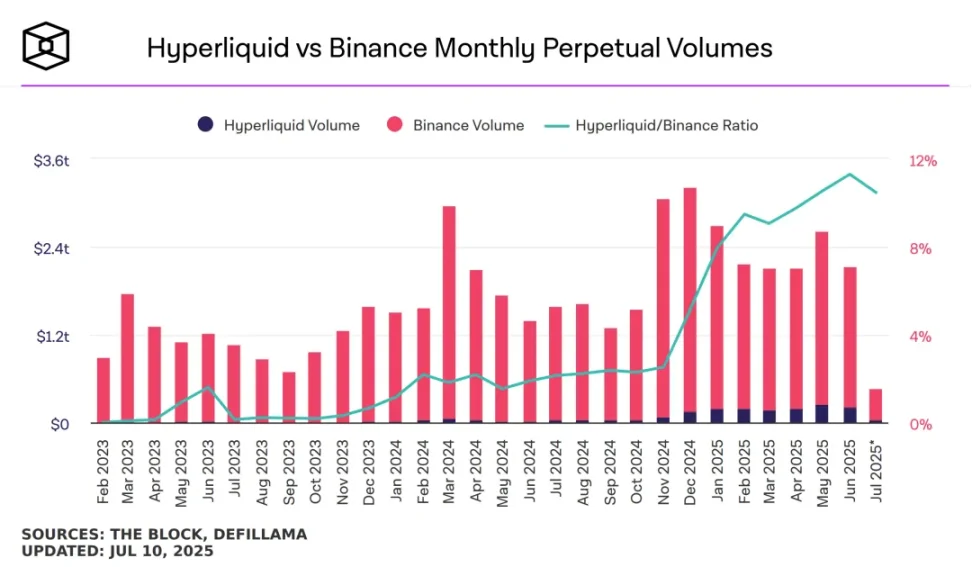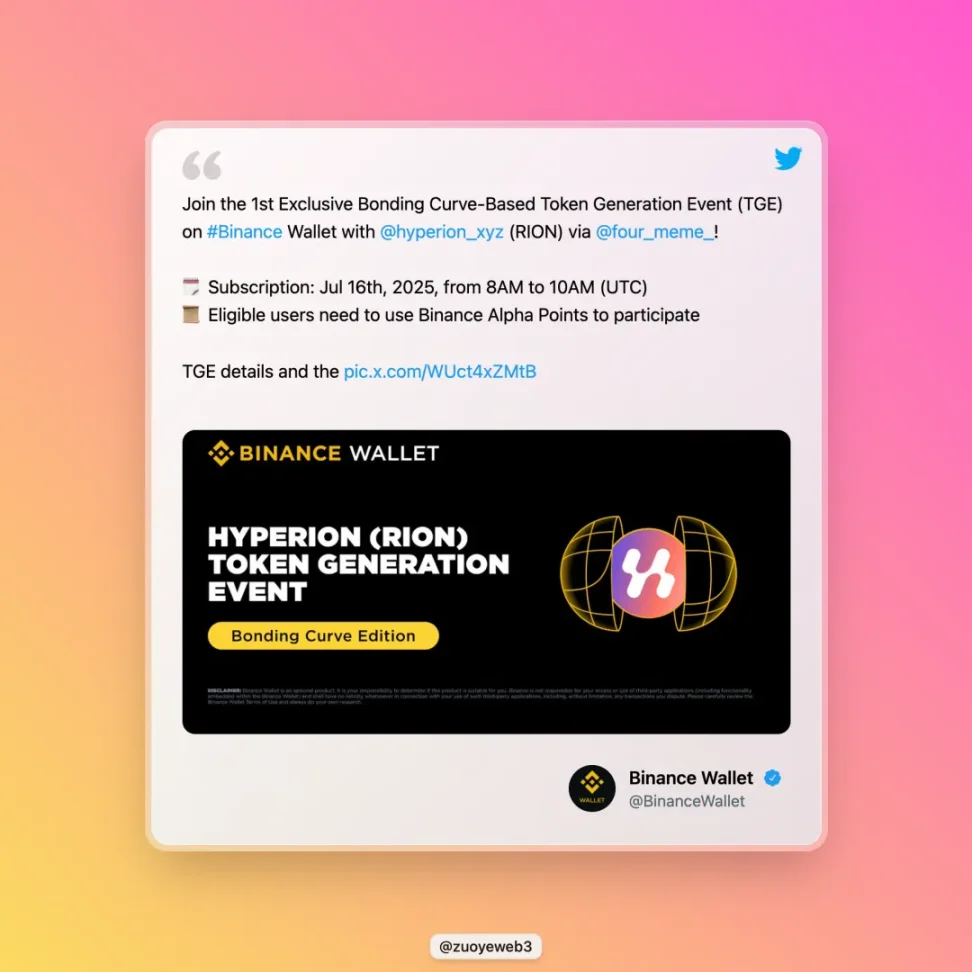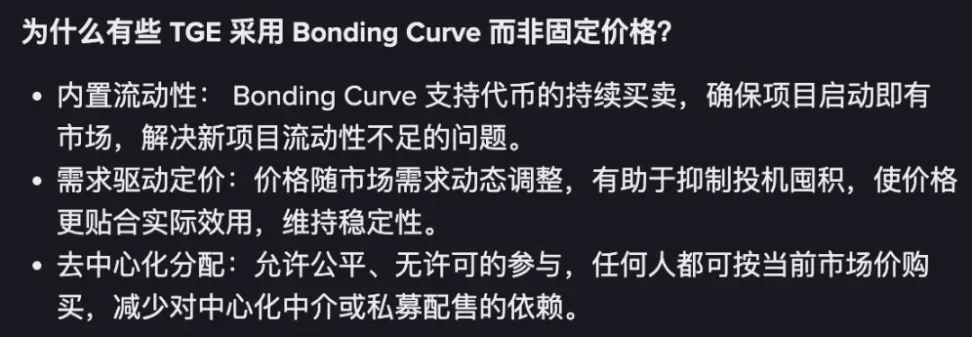Author: Zuo Ye
Think about this question: if Binance is destined to be unable to prevent the rise of Hyperliquid, then how should it maximize its benefits?

Image caption: HyperLiquid and Binance Futures trading volume comparison, Image source: @TheBlock__
At a time when $PUMP has outperformed many CEXs on Hyperliquid, Binance, which is under the greatest pressure, has responded by improving the liquidity of Binance Alpha. Please note that it is the liquidity within Alpha that is improved, not the rate of return for participants.
Listing on Binance used to mean listing on Binance spot, but now it means listing on Alpha. In order to avoid the "disappearance of Binance listing effect", it will lead to Alpha, contracts and BNB Chain. However, it would be too strange if the exchange does not do transactions, so the trading attributes of Alpha must be improved.
In addition, empowering $BNB is crucial to the entire Binance-YZi-BNB Chain system. The income of BNB holders is the daily liability of the Binance system. In addition to economic value, more use value and even emotional value must be introduced.
To summarize, Binance Alpha opens trading for two reasons:
1. Counter the Hyperliquid listing effect and increase Binance’s overall liquidity;
2. Empower $BNB with more practical value and enhance the stability of the Binance system.
On these two points, it is easy to understand why Binance cooperated with FourMeme to launch Bonding Curve and TGE. It even led FourMeme to keep up with the revival of the Meme launcher of PUMP coin issuance. After all, both Bonk and MemeCore are popular.
Select Bonding Curve to facilitate initial liquidity
According to the Binance announcement, the Bonding Curve TGE token is Aptos DEX Hyperion.
We will not introduce this project any further, and this article does not involve content such as token prices. It only explains why Binance chose Bonding Curve, so that the founder can think about future listing plans.

Image caption: @hyperion_xyz/center, Image source: @BinanceWallet
After reading the announcement, you can withdraw the BNB you need to hold, resell it in the Bonding Curve system after successful subscription, and enter the normal Alpha trading system after the event ends. In essence, this is to encourage intra-market trading, as opposed to pre-market trading in the Alpha market.
After this, Binance's trading system has at least four layers: Bonding Curve trading -> Alpha trading -> Contract trading -> Spot trading, and it is an optional upgrade system, and it may not necessarily eventually enter the Binance main site trading system.
This can just cover up or solve Binance’s biggest liquidity crisis at present, by creating more initial liquidity mechanisms. Looking back at history, Bonding Curve did not solve the problem of liquidity creation, but artificially increased the number of candidates to collide with the most likely Meme token.
Looking back at the development history of DEX, LP Token is the real tool to solve the problem of liquidity supply. AMM/order book mechanism needs to cooperate with it to support its own operation. However, Binance’s problem is a bit complicated. It is not an early project, but it has the biggest problem of early projects - liquidity is shrinking and $BNB’s value capture ability is declining.
In comparison, PumpFun is an on-market Bonding Curve + an off-market AMM pool. There is a paradox in the Bonding Curve itself - the greater the demand, the higher the price. It is like the greater the demand for buying houses, the more the houses in Yanjiao appreciate in value. Once the turning point of the market arrives, it will collapse immediately, and there is no room for a smooth decline.
PumpFun did not solve this natural paradox, but it reduced the launch cost to the extreme to attract more attempts. Will Yanjiao fall and will Dubai rise? The global liquidity and the possibility of any attempt in the currency circle make the internal market the cheapest launch site. 10 out of 1,000 internal markets are listed on the external DEX, and 1 of them is listed on CEX.
If the number of internal disks is increased to 10 million, the liquidity of the entire market will increase instantly, and the liquidity from internal disks, external disks, DEX to CEX will all surge. Of course, it will eventually collapse.
We can make a prediction here: there will be more Binance Alpha Bonding Curve TGE events in the next period of time, otherwise it will not have the effect of creating liquidity and directing it to the main site and BNB.
Going further, Bonding Curve is actually more like a Rebase stabilization mechanism. The former is based on the principle of "the more demand, the higher the price -> the better the liquidity", while the latter is based on the principle of "the more you buy, the stronger the reserve + the more you sell, the more profit you make -> the more stable the price of the stablecoin".
The problems of the two are also highly similar. They are both based on the "conventional" part of the law of large numbers, that is, they do not consider the impact of extreme events. To use the 80/20 rule, they consider 80% of the situations more and do not care about the 20% exceptions. In the end, one died from the impact of Luna-UST, and the other had its liquidity sucked dry by $TRUMP.
Study psychological momentum and wait for the ultimate blow
There is a momentum phenomenon in the market, which means it will rise higher than we predict, and vice versa, it will fall deeper than the market's fair value.
The assumptions that Bonding Curve relies on are inherently unreliable, but they are very consistent with Binance’s actual needs:
Create initial liquidity: Binance Alpha itself has sufficient market foundation, so it is not "built-in liquidity", but liquidity front-end, directing the Alpha liquidity after its opening and other DEX/CEX trading liquidity to the Bondng Curve area;
Pricing expectations trigger demand: Just as the pre-market game is about pricing, the Bonding Curve will also trigger pricing games, and then promote demand transactions. Only by selling tokens can users avoid becoming the watchers before the Bonding Curve collapses;
Digesting the listing effect: Bonding Curve is a market game. Binance can use it to avoid the weakening of the main site liquidity caused by the decline in the listing effect, and theoretically obtain fairer pricing.

Image caption: Reasons for choosing Bonding Curve, Image source: @BinanceWallet
So, what is the cost?
As mentioned earlier, the PumpFun version of Bonding Curve relies on a sufficient number of internal disks to create a super single product. There are still too few coin listing events in the Alpha activity area. Even if all project parties in the entire currency circle are pulled over, it is not enough.
However, Binance Alpha will assume the initial price discovery role of the project. Referring to $JELLYJELLY, Binance and OKX jointly attacked Hyperliquid. I personally feel that CEX will unite to target Hyperliquid, and Binance will be the first to bear the brunt.
The trick to grab liquidity is to discover prices. Retail investors all hope to buy at the lowest cost and sell at the highest profit. If Binance directly increases the listing effect, it will inevitably pay a higher price. However, in the name of helping retail investors discover the earliest prices, liquidity will naturally come.
Then, wait for an extreme black swan event to explode Hyperliquid in one fell swoop, just like Bybit was seriously injured by the theft, and CZ/Binance was fined 4.2 billion, just like Hyperliquid’s extreme transparency was reversed, and Binance followed up with a poke, just like FTX was easily pushed down, and CZ came out as the big cousin.
Conclusion
Size is Binance’s biggest advantage, and flexibility is Hyperliquid’s means of attack. Waiting for changes and fighting a war of attrition are the reasonable choices. Binance chooses price signals, and Hyperliquid moves towards the coin listing effect. Liquidity is the result of the competition between the two, not the cause.
I just feel sorry for the Alpha users. Who are the cows working so hard for? Sugar is so sweet, why do the people who grow it have such a hard life?





